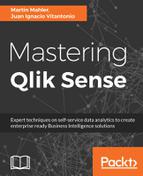There are several online blogs and articles discussing the benefits and challenges of self-service BI and more of them are expected to be released after publication of this book. This section will summarize the most relevant benefits which are applicable to Qlik Sense. The order of points is arbitrary and, to some extent, they reiterate content that has already been elaborated in this chapter:
- Empowering users: Users become self-reliant and empowered by the ability to create business intelligence apps all by themselves with little to no help from IT. They know best what they want to see and extract from their data. Self-service BI allows them to build their own personalized analytics, to their own requirements, at their own pace.
- The speed of development: If a proper framework is in place with setup access to various data sources and a controlled environment where publication of new and enriched apps is streamlined and automated, app development and the subsequent delivery of new insights can be significantly sped up. This not only delivers results and information in a timely fashion but also allows for a more agile and iterative approach to developing analytics with a short feedback cycle.
- The IKEA effect: The cognitive bias described earlier in this chapter lets users perceive the apps in which they had significant input as being much more valuable. While biased, this greatly encourages users to get involved and promotes the adoption of data analytics within the organization. As most organizations are investing to become digital and more data-driven, the adaptation of data analytics is an integral part of it and the IKEA effect certainly helps.
- Relieving IT: As organizations become more data-driven, the pressure on IT to deliver faster becomes evident. With applications deployed and used by the business, an inconvenient overhead emerges to support these applications, which prevents IT from doing any further development of new ideas and data sources. This bottleneck not only puts pressure on IT but also frustrates the business, which has to wait longer for the realization of its projects. With self-service BI, power users from the business can become an integral part of the development, relieving the pressure on IT. This frees them to think about more strategically and technically challenging tasks and focus on value-added development for the company rather than just keeping the lights on.
- Becoming proactive rather than reactive: By having the data readily available, and with the possibility of creating new analytics being easy, the business can start becoming more proactive in its culture. Rather than receiving reports, agreeing on actions, and getting a feedback report within the next cycles to confirm whether its strategy was the right one, the business can become more data-driven and not only receive a faster feedback but also spend more time investigating the data to make better-informed decisions. While this sounds like a sound generic benefit, it is only with self-service BI that this becomes possible in its most efficient way.
- Reduced technology costs: It is possible to cut down on technology costs on various ends by deploying self-service BI. For example, by reducing the involvement of IT and handing over the bulk of the development to the business user, it is not necessary to spend as much money on getting consultants on board for development purposes as with traditional BI tools. At the same time, self-service BI (with its ease of use) allows for an increased speed of development and subsequent decreased time to market, which also reduces the costs associated with deploying the technology. Lastly, due to the speed of development and the possibility of integrating agile project management with lots of iteration, as well as involving the business end user into the process, self-service BI projects can have a much higher success rate, which also effectively brings down the overall technology costs within the organization.
- Mobile: This is possible and a novelty. If Qlik Sense is set up correctly and the user has had some basic training, it is possible to create analytics and basic dashboards on mobile devices such as the iPad. Qlik Sense's ease to use and capability to create compelling dashboards allows for a pioneering way to develop on the go, something which has rarely been possible so far and only in a limited capacity.
